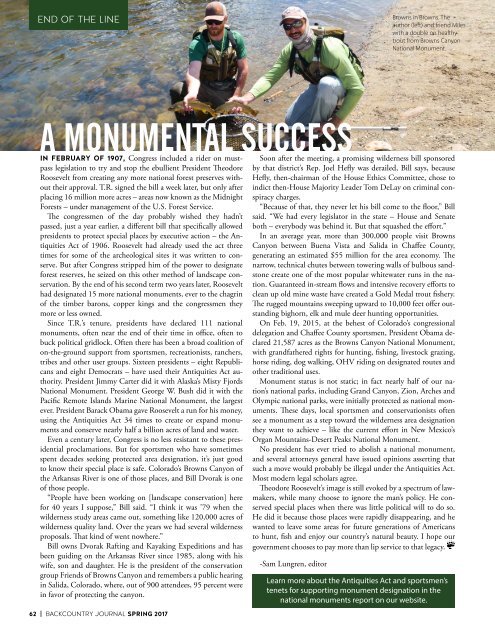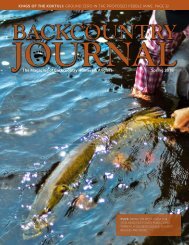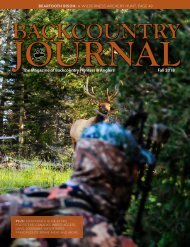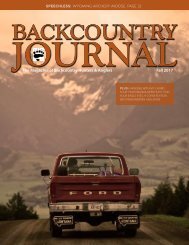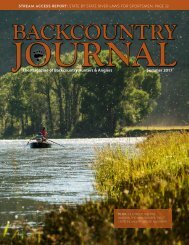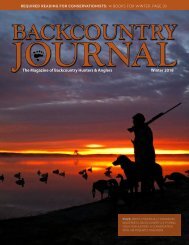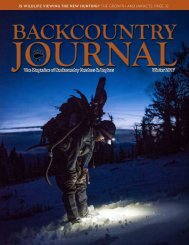BCJ_SPRING 17 Digital Edition
You also want an ePaper? Increase the reach of your titles
YUMPU automatically turns print PDFs into web optimized ePapers that Google loves.
END OF THE LINE<br />
Browns in Browns. The<br />
author (left) and friend Miles<br />
with a double on healthy<br />
trout from Browns Canyon<br />
National Monument.<br />
A MONUMENTAL SUCCESS<br />
IN FEBRUARY OF 1907, Congress included a rider on mustpass<br />
legislation to try and stop the ebullient President Theodore<br />
Roosevelt from creating any more national forest preserves without<br />
their approval. T.R. signed the bill a week later, but only after<br />
placing 16 million more acres – areas now known as the Midnight<br />
Forests – under management of the U.S. Forest Service.<br />
The congressmen of the day probably wished they hadn’t<br />
passed, just a year earlier, a different bill that specifically allowed<br />
presidents to protect special places by executive action – the Antiquities<br />
Act of 1906. Roosevelt had already used the act three<br />
times for some of the archeological sites it was written to conserve.<br />
But after Congress stripped him of the power to designate<br />
forest reserves, he seized on this other method of landscape conservation.<br />
By the end of his second term two years later, Roosevelt<br />
had designated 15 more national monuments, ever to the chagrin<br />
of the timber barons, copper kings and the congressmen they<br />
more or less owned.<br />
Since T.R.’s tenure, presidents have declared 111 national<br />
monuments, often near the end of their time in office, often to<br />
buck political gridlock. Often there has been a broad coalition of<br />
on-the-ground support from sportsmen, recreationists, ranchers,<br />
tribes and other user groups. Sixteen presidents – eight Republicans<br />
and eight Democrats – have used their Antiquities Act authority.<br />
President Jimmy Carter did it with Alaska’s Misty Fjords<br />
National Monument. President George W. Bush did it with the<br />
Pacific Remote Islands Marine National Monument, the largest<br />
ever. President Barack Obama gave Roosevelt a run for his money,<br />
using the Antiquities Act 34 times to create or expand monuments<br />
and conserve nearly half a billion acres of land and water.<br />
Even a century later, Congress is no less resistant to these presidential<br />
proclamations. But for sportsmen who have sometimes<br />
spent decades seeking protected area designation, it’s just good<br />
to know their special place is safe. Colorado’s Browns Canyon of<br />
the Arkansas River is one of those places, and Bill Dvorak is one<br />
of those people.<br />
“People have been working on [landscape conservation] here<br />
for 40 years I suppose,” Bill said. “I think it was ’79 when the<br />
wilderness study areas came out, something like 120,000 acres of<br />
wilderness quality land. Over the years we had several wilderness<br />
proposals. That kind of went nowhere.”<br />
Bill owns Dvorak Rafting and Kayaking Expeditions and has<br />
been guiding on the Arkansas River since 1985, along with his<br />
wife, son and daughter. He is the president of the conservation -Sam Lungren, editor<br />
group Friends of Browns Canyon and remembers a public hearing<br />
in Salida, Colorado, where, out of 900 attendees, 95 percent were<br />
in favor of protecting the canyon.<br />
62 | BACKCOUNTRY JOURNAL <strong>SPRING</strong> 20<strong>17</strong><br />
Soon after the meeting, a promising wilderness bill sponsored<br />
by that district’s Rep. Joel Hefly was derailed, Bill says, because<br />
Hefly, then-chairman of the House Ethics Committee, chose to<br />
indict then-House Majority Leader Tom DeLay on criminal conspiracy<br />
charges.<br />
“Because of that, they never let his bill come to the floor,” Bill<br />
said. “We had every legislator in the state – House and Senate<br />
both – everybody was behind it. But that squashed the effort.”<br />
In an average year, more than 300,000 people visit Browns<br />
Canyon between Buena Vista and Salida in Chaffee County,<br />
generating an estimated $55 million for the area economy. The<br />
narrow, technical chutes between towering walls of bulbous sandstone<br />
create one of the most popular whitewater runs in the nation.<br />
Guaranteed in-stream flows and intensive recovery efforts to<br />
clean up old mine waste have created a Gold Medal trout fishery.<br />
The rugged mountains sweeping upward to 10,000 feet offer outstanding<br />
bighorn, elk and mule deer hunting opportunities.<br />
On Feb. 19, 2015, at the behest of Colorado’s congressional<br />
delegation and Chaffee County sportsmen, President Obama declared<br />
21,587 acres as the Browns Canyon National Monument,<br />
with grandfathered rights for hunting, fishing, livestock grazing,<br />
horse riding, dog walking, OHV riding on designated routes and<br />
other traditional uses.<br />
Monument status is not static; in fact nearly half of our nation’s<br />
national parks, including Grand Canyon, Zion, Arches and<br />
Olympic national parks, were initially protected as national monuments.<br />
These days, local sportsmen and conservationists often<br />
see a monument as a step toward the wilderness area designation<br />
they want to achieve – like the current effort in New Mexico’s<br />
Organ Mountains-Desert Peaks National Monument.<br />
No president has ever tried to abolish a national monument,<br />
and several attorneys general have issued opinions asserting that<br />
such a move would probably be illegal under the Antiquities Act.<br />
Most modern legal scholars agree.<br />
Theodore Roosevelt’s image is still evoked by a spectrum of lawmakers,<br />
while many choose to ignore the man’s policy. He conserved<br />
special places when there was little political will to do so.<br />
He did it because those places were rapidly disappearing, and he<br />
wanted to leave some areas for future generations of Americans<br />
to hunt, fish and enjoy our country’s natural beauty. I hope our<br />
government chooses to pay more than lip service to that legacy.<br />
Learn more about the Antiquities Act and sportsmen’s<br />
tenets for supporting monument designation in the<br />
national monuments report on our website.<br />
Know your limits: it’s the only way you can push<br />
beyond them. Leupold ® . American to the Core.<br />
Learn more about the optics and gear that goes<br />
where others can’t at Leupold.com.<br />
LEUPOLD FULL LIFETIME GUARANTEE


